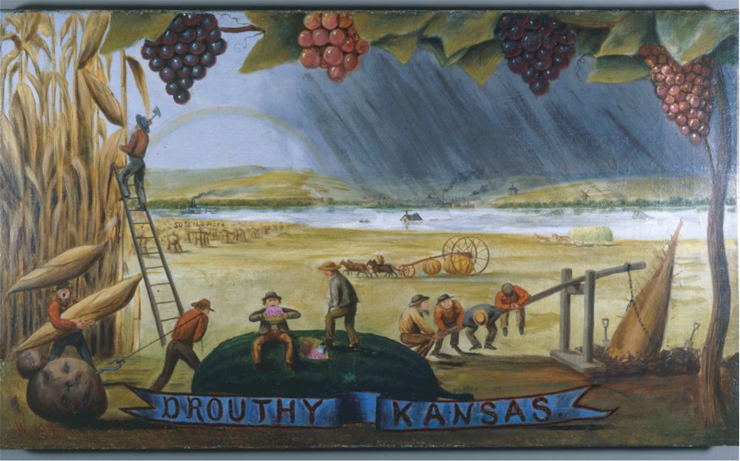The Guitar Music of Henry Worrall.
| 2016 Q3 | story by PATRICIA A. MICHAELIS, Ph.D. | photos by Steven Hertzog

Drouthy, Kansas Painting by Henry Worrall – from the Kansas State Historical Society, kansasmemory.org
What do a relatively forgotten Kansan and composer of guitar music, a Lawrence musician and “the blues” have in common? A man named Henry Worrall, who moved to Kansas from Ohio in 1868. He had published a guitar tutorial in 1856 and had also composed his best-known solo piece, “Sebastopol,” which commemorated the siege of Sebastopol (now Sevastopol) Russia by the British and French in 1855. In 2012, Brian Baggett, a jazz guitarist who lives in Lawrence, revived Worrall’s most famous piece and other compositions for a concert at the Kansas Historical Society, in Topeka.
Baggett took on the challenge of playing the guitar music composed by Worrall in the mid-nineteenth century from the original manuscript of the music. He says Worrall’s published versions were generally simplified from the original compositions. In the second half of the 1800s, guitar-playing was a popular pastime, and parlor music for guitars and other instruments was played for families and parties in the “parlor” of the home. Thus, both men and women learned the simpler versions of music on guitars that were smaller than today’s instruments. They were easy for a woman to hold in her lap while seated to play the music.
Baggett says the biggest challenge to playing the music is decoding the tuning. For guitar aficionados, the tuning was “open tuning,” but not the standard open tuning used today. Worrall also used a constant bass line that he played with his thumb, one of the aspects of Worrall’s music that is present in blues music. The open tuning is another long-term influence on more modern blues. Michael Church, digital projects archivist at the Kansas Historical Society, says solo fingerstyle guitarists Mississippi John Hurt and Sam McGee, popular folk musicians, played versions of Worrall’s guitar compositions in their live and recorded performances.
Baggett and many guitar historians believe Worrall was an innovator. He liked to play fast, in contrast to the vocal music of the era. Some of his music was whimsical, and he liked to inject humor into his compositions. Worrall was also known for his arrangement of a popular song “Spanish Fandango.” A British fingerstyle guitarist and student of American popular guitar, John Renbourn wrote to Jas Obrecht, the former editor of Guitar Player Magazine:
- “I have many other parlour pieces in open tuning from around the same time. I am in the process of comparing these with early recorded ‘folk’ versions to see how much of the originals have been retained. It looks as if a great deal has been retained, so much and fingerpicking guitar style. ‘Sebastopol’ and ‘Spanish Fandango’ were both outstandingly popular solo pieces, and their availability in print continued beyond the turn of the century.”
These two pieces were included in guitar tutorial books, and they were studied and played by many beginning guitarists at the beginning of the 20th century. Renbourn explains the Worrall connection to the blues style as follows:
- “If you can imagine a field hand … trying to fit an arhoolie [field song]across the basic chords of ‘Spanish Fandango,’ then you would be close to the moment of transformation, in my opinion. In early recorded blues— i.e. Charley Patton and his school—the harmonic language (right down to the specific chord shapes but with bluesy modification usually of one finger only) is straight from parlour music.”
Baggett explains that it was exciting and fun, but also challenging, to tackle this music that has had such a lasting influence on other music styles. His audio and video recordings of Worrall’s music are available on the Kansas Memory website at www.kansasmemory.org. (“Sebastopol” is Kansas Memory Item No. 228586.)
In Kansas history, however, Worrall is better remembered as an illustrator of life in the early years of Kansas statehood than a musician. After coming to Kansas, Worrall became known as an artist and illustrator. His work helped promote the image of the state as an area suited for agriculture. His work was aimed at dispelling the prevailing depiction as the “Great American Desert.” A self-taught artist, Worrall’s depictions of life in Kansas were described as “journalism in pictures,” because his illustrations became occasional features in eastern journals, including Harper’s Weekly and Frank Leslie’s Illustrated Newspaper. Henry Worrall’s illustration “Exodusters in Topeka: Engravings of the Barracks,” in the July 5, 1879, issue of Harper’s Weekly, documents this well-known settlement of African Americans from the south in Kansas.
Worrall’s best-known work was a painting titled “Drouthy Kansas.” Referred to as a caricature, it was drawn in 1869 when the reputation of Kansas still suffered from the drought of 1860. However, the weather in the late 1860s in Kansas produced several years of heavy rainfall and good crops. IThe paining included men climbing ladders and using hatchets to cut ears of corn from huge stalks, watermelons so big that two men could stand on them, and wheat fields yielding 50 bushels per acre, among other images. The caricature proved immensely popular; it was published on the cover page of an issue of the Kansas Farmer and was used as a broadside in advertising the same publication. It was even reproduced on the drop curtain of Liberty Hall, in Lawrence.
Worrall contributed to other works that described life in the young state of Kansas, as well. His illustrations appeared in two well-known Western history books: Joseph McCoy’s Historic Sketches of the Cattle Trade and W.E. Webb’s Buffalo Land.
Obviously, Henry Worrall was a man of many talents: composer, musician and illustrator. However, he died in 1902 and never knew, or even imagined, the impact his guitar compositions would have on the development of the blues in the 20th century. Baggett enjoyed the challenge of figuring out how to play Worrall’s manuscript music, including decoding the “tuning.” He teaches guitar and plays regularly on Wednesdays and Saturdays at the Green Lady Lounge, 1809 Grand Blvd., Kansas City, Missouri, as part of the jazz trio OJT (Organ Jazz Trio).




13 Comments
I am so grateful for your article post.Much thanks again. Want more.
Everything posted made a great deal of sense.
But, what about this? suppose you composed a catchier post title?
I ain’t saying your information isn’t solid., but suppose you added a post title that grabbed people’s attention?
I mean Lawrence in Perspective: A Riff into History is kinda plain. You
might glance at Yahoo’s home page and see how they create post headlines to get viewers to open the links.
You might try adding a video or a related picture or two to get
readers interested about everything’ve written. In my opinion, it might make your
posts a little livelier.
Nice post. I was checking continuously this blog and I’m impressed!
Very helpful info specifically the last part 🙂 I care for such information much.
I was seeking this particular info for a very long time.
Thank you and good luck.
Thank you for the good writeup. It in fact was a amusement
account it. Look advanced to more added agreeable from you!
However, how could we communicate?
This post is truly a nice one it assists new the web users, who are wishing in favor of blogging.
If some one wishes to be updated with most recent technologies
therefore he must be go to see this web site and be up to date everyday.
With havin so much content do you ever run into any problems of plagorism or
copyright violation? My blog has a lot of exclusive content I’ve either written myself or
outsourced but it seems a lot of it is popping it up all over the web without
my authorization. Do you know any techniques to
help prevent content from being ripped off? I’d really appreciate it.
whoah this blog is great i really like reading your posts. Stay up the
great work! You already know, a lot of people are searching round
for this information, you can help them greatly.
I have been surfing on-line greater than three hours as of late, yet I by no means discovered any fascinating article like yours.
It is pretty value enough for me. In my view, if all webmasters and bloggers made good content material as you probably did, the net
will be a lot more useful than ever before.
For latest information you have to visit world wide web and on world-wide-web I found this
web site as a most excellent website for most recent updates.
Hi, Neat post. There’s an issue along with your site in web
explorer, might check this? IE nonetheless is the
marketplace chief and a big section of other folks will miss your
fantastic writing because of this problem.
I am in fact happy to glance at this website posts which carries lots of helpful facts, thanks for providing such information.
I am not sure where you are getting your info, but great topic.
I needs to spend some time learning more or understanding more.
Thanks for magnificent information I was looking for
this info for my mission.